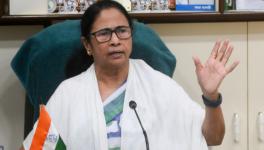City of Print

Image Courtesy: Outlook
Translation is not just about words, it is about carrying a culture, a history, a whole world into another language. Translations do not just bring languages closer to one another, they also introduce us to diverse modes of imagining and perceiving different cultures.
To mark the International Translation Day, celebrated on 30 September, the Indian Cultural Forum will be doing a series of posts to emphasise the power and importance of translations.
The arrival of the earliest threshing machines to Calcutta, at around 1825-26, generated considerable curiosity as crowds gathered by the Ganga to witness the marvelous mechanical monsters first-hand. The Bengali newspapers of the time speak of the bilati machines with the same sense of wonder, no doubt comparing their output to the traditional dhenki, “We advice all our friends to go and see for themselves this incredible steam-powered machine that can thresh two thousand manns of wheat within 24 hours.” The same steam-powered threshing machines would, of course, be held responsible for the Swing Riots that broke out in southern and eastern England in 1830, but it is uncertain if news of the same travelled back from the metropolitan center of the British Empire to the backwaters of colonial Calcutta.
The steam-powered threshing machine was not the only mechanical wonder to grace the shores of the colonial city of Calcutta at the time — printing presses had arrived earlier in colonial Bengal, in Calcutta and in Serampore, though we do not know if similar crowds gathered on the banks of the river to witness the marvels of the same. The annals of history do not tell us what the native compositors of the earliest European-owned presses thought of their encounters with the printing machines. It is, however, without question that the arrival of the printing presses would shake up the city of Calcutta. As Benoy Ghosh writes in his Kolkata Culture,
If the city of Calcutta is to be considered the center of our social or cultural reawakening, then we must recogize that it is the printed books produced by the printing presses that made this awakening possible. It is not the city of palaces or the smoke-filled industrial city, but the city of printed books that must be deemed our earliest pilgrimage. Gaud, Nabadwip, Krishnanagar, Murshidabad, Dhaka are the centers of manuscript cultures, representative of ancient and medieval cultures. Calcutta is the city of the printed book, the City of Print, representative of the culture of modernity.
Ghosh’s estimation of colonial Calcutta as the City of Print is not entirely inaccurate. The journey that began with the slow proliferation of European-owned printing presses in the last decades of the eighteenth century would lead up to a veritable explosion in the nineteenth century, starting with two significant events in the year 1800. The first of the two, of course, is the establishment of the Fort William College (on 10 July, 1800) by Lord Wellesley, who sought to use this institution to educate employees in the East India Company in Indian langauges. This, of course, was the time of the Orientalists — Macauley sahib and his Minute had not made its impact felt in policy, and neither had the English Education Act of 1835 been enacted. A simple list of the languages (and their corresponding literature) studied at the Fort William College is bound to generate awe in our increasingly monolingual times: the College was responsible for the pursuit of Arabic, Persian, Sanskrit, Bengali, Hindi, Urdu, and Marathi. Its publication unit’s output was even more astonishing: it managed to publish text books, grammar books and dictionaries in Arabic, Bengali, Burmese, Mandarin, Hindustani, Kannada, Marathi, Odiya, Punjabi, Persian, Sanskrit and Telugu. The College would boast of a faculty as learned as John Gilchrist and William Carey, as well as exceptional Indian scholars such as Mrityunjay Vidyalankar, Tarinicharan Mitra, Ramram Basu, Iswarchandra Vidyasagar and Madanmohan Tarkalankar would join the college. In hindsight, one must wonder if the laat saheb (as the Governor General was called) anticipated this flourishing of languages in his institution designed for training British officials in Indian languages, leading up to what historians often call the ‘rise’ and inevitable triumph of the modern Indian languages.
The second event — also in the year 1800 — happened in a thriving mofussil township called Serampore, about thirty kilometres away from Calcutta. The Serampore Mission Press, established by William Carey, began its journey on January, 1800. It might seem almost unbelievable now, but between 1800 and 1840, the Mission Press published around 212,000 texts in 40 different languages. Of these, there were 30 Indian languages, along with Arabic, Persian, Armenian, Burmese, Mandarin, Javanese, Malaya, Dhivehi, Singapuri and Thai. The Mission Press’ type foundry, under the able stewardship of Charles Wilkins and Panchanan Karmakar, would produce the first complete Bengali typeface, and then go on to do the same for various Indian and foreign languages. This multiplicity of languages leads Vinay Dharwadker to comment, “…the Calcutta region, as it must have been between about 1760 and 1830, seems to be the single most important site in the histories of Indo-European and general linguistics; of the translation of Asian languages from the media of voice, palm-leaf, and scroll to the medium of print; and of the mediated transposition of print culture from Europe to Asia.” This extraordinary and diverse culture of print was built on the labour, not only of the learned Orientalists and scholars at the Fort William College, but also the labour of countless unnamed print workers, whose blood and sweat made printing possible.
The heterogeneity of early nineteenth century print culture in the Calcutta region is evident, also, in the pioneering work of non-European/Bengali figures such as Lalloo Laal (or Lallooji), a scholar at the Fort William College and the progenitor of the modern Hindi khadi boli. The son of an Agra Brahmin family, Lallooji had came to Murshidabad to work for the nawab. After a seven year stint at Murshidabad, the Orientalist John Gilchrist brought him to Fort William College, where he worked for another 24 years. Lallooji’s Prem Sagar (based on the 10th book of the Bhagavata Puran), composed between 1804 and 1810, is one of the earliest examples of modern Hindi prose. Or, for instance, Baburam (who came to Calcutta from Mirzapur in Uttar Pradesh,), who built the Sanskrit Press in 1807 with the assistance of Henry Colebrooke. The Sanskrit Press was the first Indian-owned press in Calcutta, and would go on to publish Prem Sagar, as well as many other books in Bengali, Hindi, and Sanskrit. Baburam is said to have earned close to 4 lakh rupees in his eight year stint at the Sanskrit Press, after which he sold it to Lallooji in 1815. Lallooji kept it functional till his retirement, following which he took it with him to Agra.
Lallooji would breathe his last soon after reaching Agra, but his journey upstream with the Sanskrit Press printing machine, in many ways, stands as an enduring symbol of the networks of print at the time. The earliest printing presses came to Calcutta from across the seas and via the Ganga, as did the earliest technicians of print. The labour and technology of print followed the flow of the river and spread via the Ganga to Benares, Lucknow, Allahabad, building new centers of print. The river would carry the affordable Patna-produced paper (albeit inferior in quality to European paper) to Calcutta, just as paper produced in mills in Serampore and Bali would eventually become a staple at Munshi Nawal Kishore’s eponymous Lucknow press. Enterprising Bengali men such as Babu Kedarnath Ghosh and Kali Prasad Bag would go on to open short-lived ventures such as the Baag-o-Bahaar Press in Benares in 1848, patronised by the Maharaja of Benares, or the more successful Kashi Yatra Patrika published by Kashidas Mitra’s Kashi Press, catering to the Bengali population in the city.
This distinctive heterogeneity that marks the early days of print across eastern and northern India, along with the multiplicity of languages that flourished in its wake, might prove somewhat difficult to comprehend in this golden era of neoliberal economics, driven by the monolingual impulse of English — the language of power and capital. This, accompanied by the aggressive expansion of Hindi — often at the behest of the Indian state — has in many ways swallowed up dialects and cultures adjacent to Hindi (such as Awadhi or Magadhi), or resulted in contesting and muscular linguistic subnationalisms, often with scant regard for diversity. Turning our gaze at the early days of print in India, and the multiplicity of languages that flourished along with it, might offer important insights for our increasingly fractured and monolingual times.
Get the latest reports & analysis with people's perspective on Protests, movements & deep analytical videos, discussions of the current affairs in your Telegram app. Subscribe to NewsClick's Telegram channel & get Real-Time updates on stories, as they get published on our website.
























